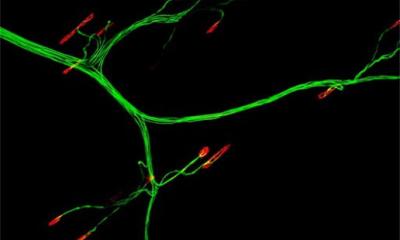News • Intracardiac nervous system
The heart has its own ‘brain’
New research from Karolinska Institutet and Columbia University shows that the heart has a mini-brain – its own nervous system that controls the heartbeat.

© Sebastian Kaulitzki – stock.adobe.com
A better understanding of this system, which is much more diverse and complex than previously thought, could lead to new treatments for heart diseases. The study, conducted on zebrafish, is published in Nature Communications.
The heart has long been thought to be controlled solely by the autonomic nervous system, which transmits signals from the brain. The heart’s neural network, which is embedded in the superficial layers of the heart wall, has been considered a simple structure that relays the signals from the brain. However, recent research suggests that it has a more advanced function than that.
Scientists have now discovered that the heart has its own complex nervous system that is crucial to controlling its rhythm.

Image source: Karolinska Institutet; photo: Stefan Zimmerman
“This ‘little brain’ has a key role in maintaining and controlling the heartbeat, similar to how the brain regulates rhythmic functions such as locomotion and breathing,” explains Konstantinos Ampatzis, principal researcher and docent at the Department of Neuroscience, Karolinska Institutet, Sweden, who led the study.
The researchers identified several types of neurons in the heart that have different functions, including a small group of neurons with pacemaker properties. The finding challenges the current view on how the heartbeat is controlled, which may have clinical implications. “We were surprised to see how complex the nervous system within the heart is,” says Konstantinos Ampatzis. “Understanding this system better could lead to new insights into heart diseases and help develop new treatments for diseases such as arrhythmias.”
The study was conducted on zebrafish, an animal model that exhibits strong similarities to human heart rate and overall cardiac function. The researchers were able to map out the composition, organisation and function of neurons within the heart using a combination of methods such as single-cell RNA sequencing, anatomical studies and electrophysiological techniques. “We will now continue to investigate how the heart’s brain interacts with the actual brain to regulate heart functions under different conditions such as exercise, stress, or disease,” says Konstantinos Ampatzis. “We aim to identify new therapeutic targets by examining how disruptions in the heart’s neuronal network contribute to different heart disorders.”
The study was done in close collaboration with researchers at Columbia University, USA, and was funded by, among others, the Dr. Margaretha Nilsson Foundation, Erik and Edith Fernström Foundation, StratNeuro and Karolinska Institutet. There are no reported conflicts of interest.
Source: Karolinska Institutet
09.12.2024











